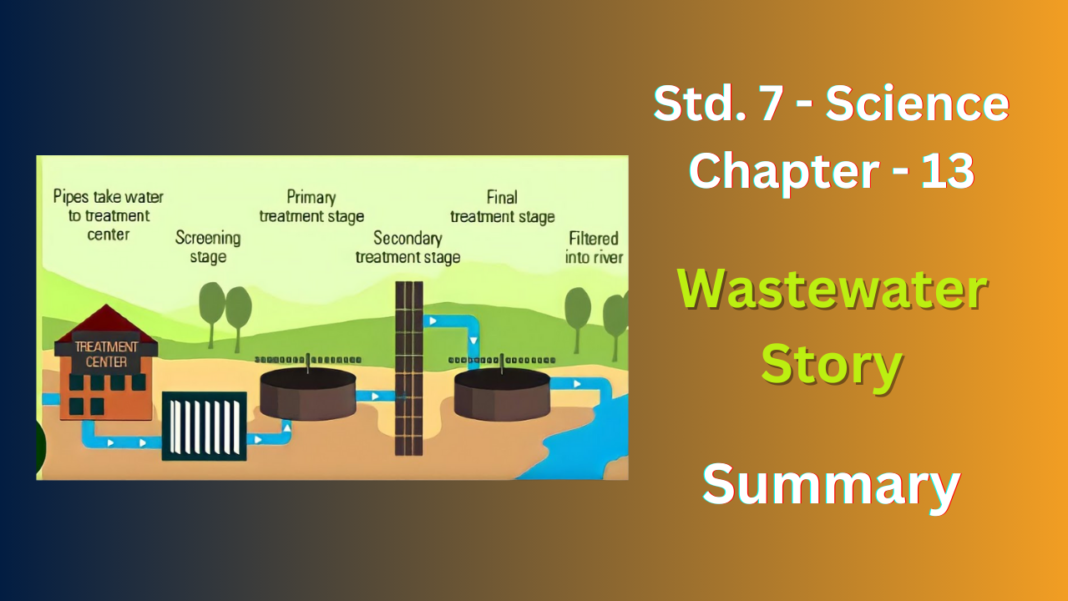NCERT Solutions for Class 7 Science Chapter 13
Ever wonder what happens to the water you use for flushing toilets, showering, and washing dishes? The chapter Wastewater story dives into the journey of wastewater, highlighting the importance of proper treatment before it re-enters the environment.
Wastewater Defined:
- Wastewater refers to the used water generated in homes, industries, and other establishments. It contains dirt, soap, food scraps, and other contaminants.
Why Treat Wastewater?
- Untreated wastewater can be harmful to the environment. It can:
- Pollute water sources like rivers and lakes, making them unsafe for drinking, swimming, and aquatic life.
- Spread diseases if it comes into contact with clean water sources.
The Treatment Process:
Wastewater treatment plants play a crucial role in purifying wastewater before releasing it back into the environment. Here’s a simplified breakdown of the process:
- Screening: Large objects like rags, sticks, and plastics are removed using screens and filters.
- Grit Removal: Sand, gravel, and other heavy particles settle at the bottom of tanks, allowing cleaner water to flow further.
- Primary Treatment: Wastewater is allowed to settle in large tanks. Heavier organic matter sinks to the bottom as sludge, and lighter materials like oil and grease float to the top, both of which are removed.
- Secondary Treatment: Microorganisms (bacteria) are introduced into the wastewater to break down remaining organic matter. This process mimics natural decomposition.
- Tertiary Treatment: Additional treatment processes might be employed for further purification, depending on the intended reuse of the treated water. This can include processes like disinfection to kill harmful bacteria.
The Importance of Wastewater Treatment:
- Protects human health and the environment by preventing water pollution.
- Enables the reuse of treated wastewater for irrigation or other non-drinking purposes, conserving freshwater resources.
What You Can Do:
- Be mindful of what you flush or pour down the drain to avoid introducing harmful substances into the wastewater system.
- Conserve water by fixing leaky faucets and taking shorter showers to reduce the amount of wastewater generated.
NCERT Solutions for Class 7 Science Chapter 13
Exercises
1. Fill in the blanks:
(a) Cleaning of water is process of removing __________
(b) Wastewater released by houses is called __________.
(c) Dried __________ is used as manure.
(d) Drains get blocked by __________ and __________.
Ans :
(a) contaminants.
(b) domestic wastewater.
(c) sludge
(d) grease and solids
2. What is sewage? Explain why it is harmful to discharge untreated sewage into rivers or seas.
Ans : Sewage is dirty water from homes (food scraps, poop, chemicals). Dumping it untreated into rivers and oceans is bad because:
- Polluted water: It makes the water dirty and harmful for fish and other living things.
- Sick people: Disease-causing yucky stuff in sewage can spread and make people sick.
- Unbalanced ecosystem: Too much sewage can mess up the natural balance in the water, harming everything that lives there.
3. Why should oils and fats be not released in the drain? Explain.
Ans :
- Clogged Pipes: Oils and fats cool down and solidify in the colder pipes. Over time, this build-up can cause blockages, leading to slow drainage or even complete clogs. This can be expensive and inconvenient to clear.
- Sewer System Strain: The same issue happens in sewer lines. Fats solidify and contribute to blockages in the larger sewer system, requiring more frequent maintenance and potential overflows.
- Harm to Treatment Plants: Fats can interfere with the wastewater treatment process at sewage treatment plants. They can coat bacteria used in the breakdown process, hindering their effectiveness in cleaning the water.
- Clogged Pipes: Oils and fats cool down and solidify in the colder pipes. Over time, this build-up can cause blockages, leading to slow drainage or even complete clogs. This can be expensive and inconvenient to clear.
- Sewer System Strain: The same issue happens in sewer lines. Fats solidify and contribute to blockages in the larger sewer system, requiring more frequent maintenance and potential overflows.
- Harm to Treatment Plants: Fats can interfere with the wastewater treatment process at sewage treatment plants. They can coat bacteria used in the breakdown process, hindering their effectiveness in cleaning the water.
4. Describe the steps involved in getting clarified water from wastewater.
Ans :
- Screening: Large objects like rags, sticks, and plastics are removed using screens and filters to prevent damage to equipment further down the line.
- Grit Removal: Sand, gravel, and other heavy particles settle at the bottom of tanks due to gravity. This allows cleaner water to flow for further treatment.
- Primary Treatment: Wastewater is held in large tanks. Heavier organic matter like food scraps and solids settle to the bottom as sludge, which is removed. Lighter materials like oil and grease float to the top and are skimmed off.
- Secondary Treatment: Microorganisms (bacteria) are introduced into the water in large tanks. These bacteria act like tiny decomposers, breaking down remaining organic matter in the wastewater. This mimics natural decomposition that occurs in rivers and lakes.
- Tertiary Treatment (Optional): Depending on the intended reuse of the treated water, additional processes might be employed. This stage could involve:
- Sedimentation: Removing any remaining small particles that settled after secondary treatment.
- Disinfection: Using chlorine or ultraviolet light to kill harmful bacteria and viruses to ensure the safety of the treated water.
5. What is sludge? Explain how it is treated.
Ans : Sludge is leftover ick from wastewater treatment (food scraps, poop, etc.). Here’s how they deal with it:
- Thicken it up: Squeeze out some water to make it easier to handle.
- Break it down: Use friendly bacteria to reduce odors and icky stuff.
- Squeeze out more water: Make it less soupy for easier transport.
- Disposal options:
- Landfill (if safe).
- Burn it (with pollution control).
- Use it as fertilizer (sometimes, with care).
6. Untreated human excreta is a health hazard. Explain.
Ans : Untreated human excreta (waste) is a health hazard for several reasons
- Spreads icky stuff: Disease-causing germs can spread through water or by flies, making people sick.
- Pollutes water: Dirty water becomes unsafe for drinking, swimming, and even playing in.
- Contaminates soil: Contaminated soil can make it risky to grow food or raise animals.
7. Name two chemicals used to disinfect water.
Ans :
- Chlorine: This is a widely used and effective disinfectant that eliminates harmful bacteria and viruses in water. It works by disrupting the cell walls of these microorganisms.
- Chlorine dioxide: This is another disinfectant option, sometimes used in place of chlorine or as a supplement. It is effective against a broader range of microorganisms than chlorine and can also help reduce taste and odor problems in water.
8. Explain the Junction of bar screens in a wastewater treatment plant.
Ans : Bar screens are wastewater treatment’s trash collectors! They’re at the beginning, filtering out big things like rags and sticks to protect the rest of the treatment process. Imagine them as giant sieves for gross stuff!
9. Explain the relationship between sanitation and disease.
Ans : Sanitation and disease have a very close and reciprocal relationship. Here’s why:
- Poor Sanitation Leads to Disease: Lack of proper sanitation facilities like toilets and sewage treatment allows human waste to accumulate and come into contact with water sources or flies. This waste can contain harmful germs like bacteria, viruses, and parasites that cause various diseases such as cholera, dysentery, typhoid, and hepatitis.
- Disease Outbreaks Affect Sanitation: When disease outbreaks occur, they can overwhelm sanitation systems. People who are sick may be unable to properly dispose of waste, further contaminating the environment and worsening the spread of the disease.
10. Outline your role as an active citizen in relation to sanitation.
Ans : Be a sanitation superhero! Here’s how:
- Bin it right: Throw trash in bins, not on the ground.
- Save water: Shorter showers, fix leaks, water plants wisely.
- Clean food handling: Stop germs from spreading when you cook.
- Spread the word: Teach others about good sanitation habits.
- Report problems: Tell someone if you see overflowing bins or blocked drains.
- Get involved: Join clean-up drives and promote eco-friendly living.
11.Here is a crossword puzzle. Good luck!
Across:
3. Liquid waste products
4. Solid waste extracted in sewage treatment
6. A word related to hygiene
8. Waste matter discharged from human body
Down:
1. Used water
2. A pipe carrying sewage
5. Micro-organisms which cause cholera
7. A chemical to disinfect water
Ans :
Across:
3. Liquid waste products – WASTEWATER
4. Solid waste extracted in sewage treatment – SLUDGE
6. A word related to hygiene – SANITATION
8. Waste matter discharged from human body – EXCRETA
Down:
1. Used water – SEWAGE
2. A pipe carrying sewage – SEWER
5. Micro-organisms which cause cholera – BACTERIA (or VIRUSES)
7. A chemical to disinfect water – CHLORINE
12. Study the following statements about ozone:
(a) It is essential for breathing of living organisms.
(b) It is used to disinfect water.
(c) It absorbs ultraviolet rays.
(d) Its proportion in air is about 3%.
Which of these statements are correct?
(i) (a), (b) and (c) (ii) (b) and (c) (iii) (a) and (d) (iv) All four
Ans : (ii) (b) and (c).
NCERT Solutions for Class 7 Science Chapter 13
FAQ’s
What topics are covered in NCERT Solutions for Class 7 Science Chapter 13, “The Wastewater Story”?
Chapter wastewater story covers various aspects of wastewater management, including sources of wastewater, the importance of wastewater treatment, different methods of sewage treatment, and the significance of clean water for human health and the environment.
Why is wastewater management important?
Wastewater management is crucial for preventing water pollution, protecting human health, and preserving the environment. Proper treatment of wastewater ensures that harmful contaminants are removed before the water is released back into natural water bodies, reducing the risk of waterborne diseases and ecological damage.
What are the different methods of sewage treatment discussed in Chapter 13
Chapter 13 discusses various methods of sewage treatment, including primary treatment, secondary treatment, and tertiary treatment. These methods involve physical, chemical, and biological processes to remove pollutants from wastewater and make it safe for disposal or reuse.
How can students benefit from studying “The Wastewater Story” with NCERT Solutions for Class 7 Science Chapter 13?
By using NCERT Solutions for Class 7 Science Chapter 13, students can gain a deeper understanding of the challenges and solutions associated with wastewater management. These solutions provide step-by-step explanations and examples that help students grasp complex concepts and apply them to real-world scenarios.
Are NCERT Solutions for Class 7 Science Chapter 13 aligned with the CBSE curriculum?
Yes, NCERT Solutions for Class 7 Science Chapter 13 are designed to align with the CBSE curriculum. They cover the topics and concepts specified in the CBSE syllabus for Class 7 Science, ensuring that students receive comprehensive and accurate information.
What are the key concepts covered in NCERT Solutions for Class 7 Science Chapter 13, “The Wastewater Story”?
NCERT Solutions for Class 7 Science Chapter 13 cover essential topics related to wastewater management, including the sources of wastewater, methods of sewage treatment, the importance of clean water, and the environmental impact of inadequate wastewater management practices.









